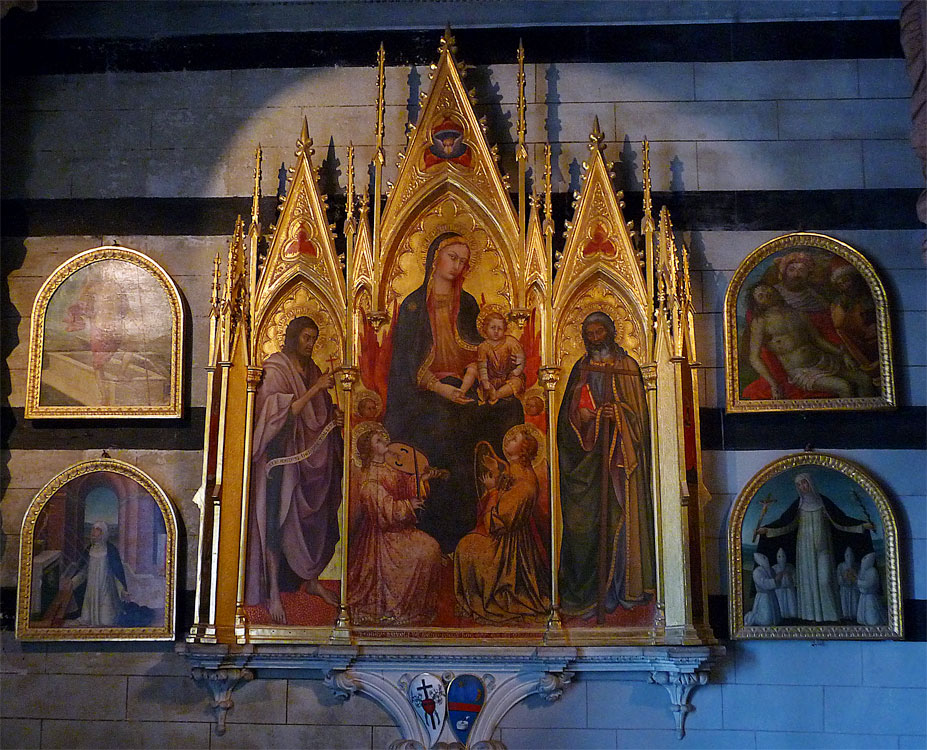Friday 21st August
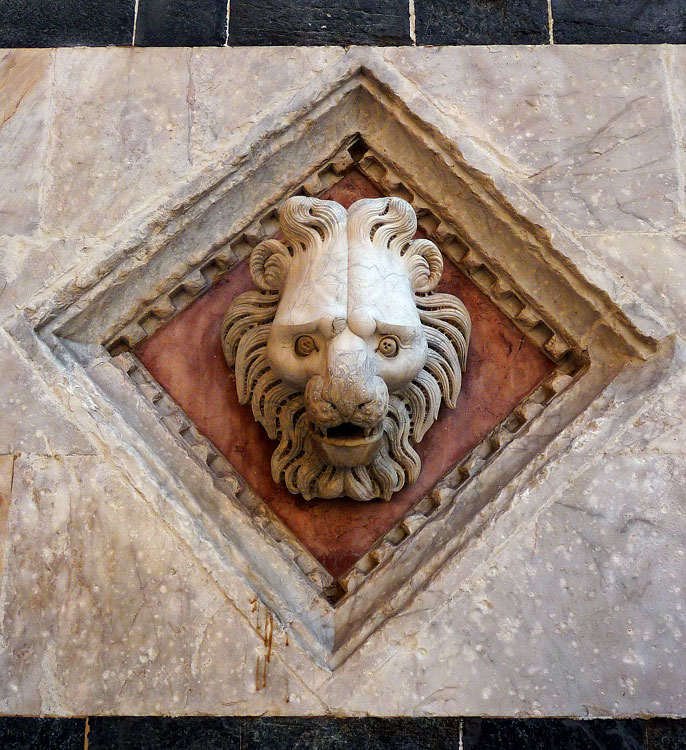 Today I went to Sienna and purchased a shirt. Obviously that wasn’t all I did, but I thought I’d get it out of the way first, as it’s been brewing for a while. Having avoided temptation yesterday, half way to the Pitti Palace, today it was just too much.
Today I went to Sienna and purchased a shirt. Obviously that wasn’t all I did, but I thought I’d get it out of the way first, as it’s been brewing for a while. Having avoided temptation yesterday, half way to the Pitti Palace, today it was just too much.
I didn’t give in at once, having lingered longingly on the way up the hill. I waited all day, then just happened to pass by on the way down…OK, that’s a lie, I went out of my way, got slightly lost, doubled back…I’m ably assisted in my folly by a charming sales-lady. In the course of selling me a lovely linen shirt for €25, I learn that she’s a biology graduate who can’t get a job in science. She lives in Montalpucino (2nd best place in Italy for wine) and works in Sienna. Her partner (or father, I’m not quite sure which) has to work in Rome. It’s tough all over, the credit crunch is biting here as well…e vero!
I’ve purchased a shirt, and now I’m not feeling as guilty as I should, given the parlous nature of my finances, just tired, very footsore and lonely.
I’ve been expecting it…comes a time on every trip when, despite the manifest advantages of solo travel, you just want to talk to someone…in English. Never mind. Well, not much, not enough to do anything about it….which is the root of the problem right there, when you get down to it.
But what about Sienna? Sienna is fab – un-spoilt mediaeval city centre and some world class art plus one seriously stunning space – Il Campo, the main piazza is justly renowned. An absolutely gorgeous place, rose-red, scallop shaped, divided into 9 sections commemorating both the rule by the Council of 9 and the folds of the Virgin’s cloak. Everything about it works; it’s harmonious, well proportioned, surrounded by lovely buildings and, as you enter, blinking in the sudden light from one of the streets feeding into it, deeply theatrical. As if the old city has been holding this up her sleeve, then…..taadaaa! If this doesn’t snatch your breath and make you smile, there’s really no hope for you.
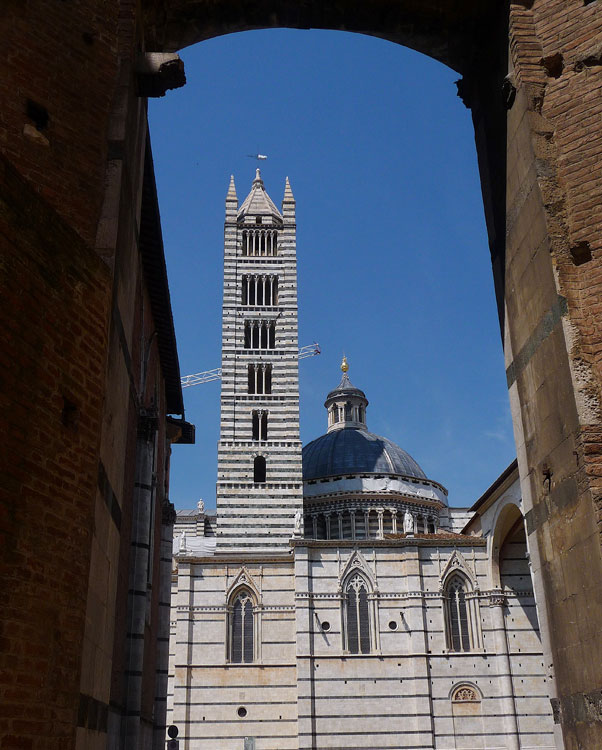 Annoyingly, the combination of attractions I really want isn’t available on one ticket, so I decide to forgo the pleasures lurking inside the Duomo – apart from the Baptistery, all painted and lovely.
Annoyingly, the combination of attractions I really want isn’t available on one ticket, so I decide to forgo the pleasures lurking inside the Duomo – apart from the Baptistery, all painted and lovely.
There seems to be a general rule against photography (exception, for some reason, the Baptistery again). Considering the fame of the frescos in the Palazzo Pubblico, and the general high quality of the art elsewhere, I feel this is mean spirited. Banning flash is OK, but if you’re going to bar photography altogether, then I think you have to offer better than the rather poor reproductions available on postcards, or expensive guide books.
Is this where I mention that Sienna is home to the oldest operating bank in the world, Monte dei Pasche de Sienna, still a major player on the Italian financial stage? I do believe it is. I’m unsurprised to read that they own some of the best art in Sienna, which can be viewed….if one writes to obtain permission. In fairness, I should also mention that in addition to the handsome Palazzos which were their original headquarters, they’ve also provided Sienna with its best and most interesting piece of modern architecture. A complex extension to the old buildings, completely invisible from the front, which stretches down the hill behind them both.
I don’t know if it’s the hills (Sienna is built across three hills, many of the streets are quite steep), the even higher buildings than Lucca, combined with the somewhat formal, dripping with gold Siennese style of art, but I get the sense that you have to work for it in Sienna. It seems like it’s all there to be seen, and the centre of the old city (centro storico) is small, but it’s hard to figure out the geography – what with the hills, and the height of the walls…there’s something a bit closed-in about the place.
Intriguing, but I can’t help thinking about the walls around the old city, and the bloody past. Sienna makes me think about some of the darker aspects of the middle ages; the endless warring between the city states and the Vatican, the legendary cruelty of the roaming bands of condottiére (mercenary soldiers) who did most of the fighting, the appalling persecutions of heretics, the unconscionable manoeuvrings of the banking clans, twisting and turning always to keep the advantage. We’re not quite as openly bloody (well, not at home, at least) these days, but this, too, is a part of our heritage….many of the financial structures still driving everything were invented in places like this.
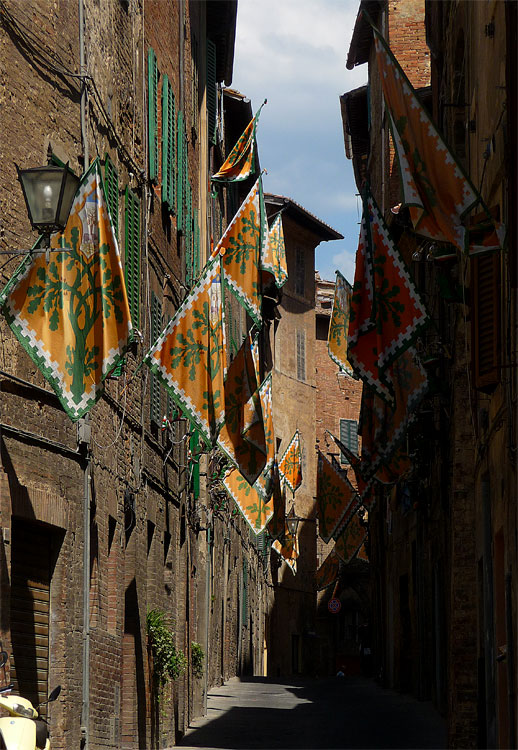 Or maybe I’m just getting tired…look at those lovely flags all over the place, they’re all very festive….except they mark out the territories of the contrade (parishes) who compete in the Pallio (the famous bare-back horse race around the Campo), and just about everything else…I suspect you have to be born here to really understand. Open display and multiple layers of meaning…not that the display isn’t magnificent.
Or maybe I’m just getting tired…look at those lovely flags all over the place, they’re all very festive….except they mark out the territories of the contrade (parishes) who compete in the Pallio (the famous bare-back horse race around the Campo), and just about everything else…I suspect you have to be born here to really understand. Open display and multiple layers of meaning…not that the display isn’t magnificent.
Like the frescos in the Palazzo Pubblico, room after room of dazzling work, including the famous allegories of good and bad government – painted by Lorenzetti in 1338 – pointed reminders to the councillors meeting in that room of the larger consequences of their decisions. So magnificent is it all that I find that I have to keep reminding myself that this is the Town Hall….this is the Town Hall…staggering testimony to the wealth and power of the place…but this is the Town Hall…inspiration, one suspects, of a thousand pale imitations scattered all over Europe; tasteful but essentially empty monuments to civic pride.
 In addition to the allegories – ‘Andrew Grahame Dixon stood here’, a thought which gets me slightly over excited – I come across another very familiar image (The knight on the horse with the vivid orange-yellow surcoat) which pops up in virtually every book about chivalry or the middle ages. It’s called the Equestrian Portrait of Guidoriccio da Fogliano and is attributed to Martini, although apparently the experts have been arguing over it for ages. In truth, I find myself not really caring who painted it, and I know I’ll never remember the proper title, but I’m very thrilled to have seen it in the flesh, so to speak.
In addition to the allegories – ‘Andrew Grahame Dixon stood here’, a thought which gets me slightly over excited – I come across another very familiar image (The knight on the horse with the vivid orange-yellow surcoat) which pops up in virtually every book about chivalry or the middle ages. It’s called the Equestrian Portrait of Guidoriccio da Fogliano and is attributed to Martini, although apparently the experts have been arguing over it for ages. In truth, I find myself not really caring who painted it, and I know I’ll never remember the proper title, but I’m very thrilled to have seen it in the flesh, so to speak.
Once I can tear my eyes away from the familiar, worldly image, I’m rewarded with quite a different experience – a glorious, highly decorative Maestà, (Virgin surrounded by Saints/Angels) this one is indisputably by Martini, and very very lovely.
I’ve managed to resist the temptation to climb the huge tower attached to the Palazzo Pubblico, the Torre Mangia (the name commemorates a particularly rapacious minor official – mangiare, or ‘eater’) – but I needn’t have worried about missing the view. There’s no shortage of high vantage points, including the rear loggia of the Palazzo Pubblico which offers a great panorama of the surrounding countryside. Later on, I got some great views across the old city by snaking up the seemingly endless windy, narrow stair to the Panorama del Facciatone. This involves access to a (terrifyingly) narrow walkway across the top of vertiginously high wall set at right angles to the rear of the Duomo – relic of a hugely ambitious mid 14th C scheme to extend the Duomo, which would have resulted in it becoming easily the largest building in Italy. The plan was brought to an abrupt halt by the black death.
Across the Piazza from the Duomo is the Santa Maria della Scala. This huge complex of buildings, Sienna’s hospital for over 800 years, is currently being developed as the city’s major cultural complex. They haven’t finished it yet, so it’s currently an endearing, but confusing, mixture of wobbly old card notices and smartly etched glass information panels. They also haven’t quite worked out how to explain, or signpost, the apparently endless warren that lurks behind the innocent looking outer walls, so it’s very much a voyage of random discovery. Making me an even more unreliable narrator than usual – there could be whole worlds hidden away in there, for all I know.
It’s all a bit eccentric, but rather enjoyable, starting as soon as you step inside. Out of the achingly bright sunlight into the cavernous, cool dimness of an enormous room. The ticket desk and a small gift shop huddle in one corner, there might have been a painting on one wall. Mainly, though, I remember this great space as being full of the most delicious, soft, diffused light; the happiest result I’ve yet seen of the (almost universal, very sensible) local habit of draping windows with swathes of gauze.
Following my nose down a wide, long corridor, the first surprise occurs almost immediately. There’s a smallish chapel off the corridor, and at first I think it’s closed to the public, on account of it being full of scaffolding, swathed in deep blue cloth. But no – they are in the process of restoring the frescos, but you are allowed to climb up and have close look for yourself. At first I can’t quite believe this, but I’ve got a ticket, so the stern attendant lady irritably waves me into the room. Which I have completely to myself. Still smarting from the universal ‘no-photos’ rule, I immediately whip my camera out of my pocket and turn it on…so I do have a few (admittedly not very good – there wasn’t much light) photos, but there’s really no need, as I’m sure I’ll remember this.
It’s such a treat to be able to get so close – I could reach out and touch the paintings (I don’t, I hasten to add – I’m not completely stupid), and can trace the artist’s individual paint strokes. I think they’re mid 15thC, by Vecchietta, but I could be mis-reading the guidebook….and it’s hard to get a sense of the overall effect, as you can’t step back and see the whole. This only serves, however, to increase my respect for whoever painted this in the first place – quickly, section by section, before the plaster dried, with only candles for illumination, and probably bent into all sorts of weird shapes to get brush to plaster. Amazing.
Almost immediately it gets even better, as the corridor leads you into the Sala del Pellegrinaio (Pilgrim’s Room), one of the famous bits. This huge room, originally a hospital ward, was decorated in the mid 15thC with a series of frescos by Vecchietto and Bartolo. Unusually (for that time) the subjects were mainly secular, depicting the early history of the Hospital and the scala (ladder to heaven) from which it takes it’s name on one wall. The other side has a series of scenes illustrating the hospital’s many charitable functions. Full of colour and incident, they preserve many fascinating details of mid 15thC Siennese life – you can almost hear the babble of voices from the hundreds of individual faces that people the vivid scenes.
There’s a helpful series of sloping wooden interpretive panels (in Italian – I wonder if they have any plans for other languages) which also happen to be at exactly the right angle to provide a comfy backrest. Sit on the floor and lean back, as I did, and you’re at just the right angle to gaze at the scene on the opposite wall – I suspect a happy accident, but appreciated none the less, as the works are quite high up on the walls, and my neck’s starting to suffer a bit from so much upward inclination. Plus you can easily enjoy the lovely ceiling, with finely painted ribs and vaults
I could happily stay here for hours, but eventually fall prey to the ‘there’s lots more to see, hurry up or you’ll miss it’ demon, and drag myself upright and totter onwards…through a strange series of rooms with peculiarly baggy, beige carpeting, displaying what seems like a random collection of small chunks of sculpture, manuscripts, vestments and other ecclesiastical paraphernalia. There are hardly any labels (in any language) to guide you, and one senses this is a temporary bit, whilst they’re preparing something more exciting behind the scenes. The end of this series of rooms has some rather lovely frescoing on the ribs and ceiling of a handsomely barrel-vaulted roof. Is this the Capella del Sacro Chiodo (Chapel of the Sacred Nail), or was that the one full of scaff? Hard to say.
I vaguely remember that there’s an upstairs, but I take the downward option, instead, wondering through a couple of underground offertories dedicated to the Virgin and the local saint, Catherine of Sienna. I’ve never been anywhere quite like this before, and they strike me as being distinctly peculiar, almost spooky. There’s a real labyrinth of dimly lit (by weak bulbs and the occasional stray beam of natural light, deflected from who knows where) slightly dank rooms down here. It’s hard to tell where one chapel ends and the next one starts. Mostly, the panelled wooden walls and vaguely baroque moulded decorations are painted dark grey, the floors are dark marble slabs or creaking boards. There’s the odd dull gleam of white marble, and one very fine gilded altar-piece, but in general it’s a gloomy transit which adds to my impression of Sienna as a somewhat inward place.
I retrospect, I honestly don’t know quite what to make of this interlude – in striking contrast to the lofty, airy spaces (Churches and Chapels both) I have been exploring up to now, these troglodyte places seem to spring from a completely different part of the spiritual spectrum; private, almost furtive, superstitious. You begin to hear yourself breath in the dim chill and it’s not a very comforting sound. Half-forgotten, jumbled snatches of tales of hidden knowledge and strange heresies loom out of the shadows…Dan Brown’s wilder imaginings don’t seem quite so daft, down here…scary thought indeed.
 Round a corner, and, pretty well without warning, I’m in a very long underground corridor, which vanishes deep into the bowels of the hill. Heading instinctively towards the light, I’m briefly tempted by the small archaeological museum, off the corridor, but I’ve been underground for too long. I need light, warmth and gelato…not necessarily in that order.
Round a corner, and, pretty well without warning, I’m in a very long underground corridor, which vanishes deep into the bowels of the hill. Heading instinctively towards the light, I’m briefly tempted by the small archaeological museum, off the corridor, but I’ve been underground for too long. I need light, warmth and gelato…not necessarily in that order.
A bit later, sticky and (temporarily) sated, I head for the Museum dell’opera del Duomo Oh what a surprise, photos are forbidden…drat, there’s a fab carved stone lion over there, would be a great addition to my growing collection. Muttering slightly, I dutifully troop through the statuary, unmoved, for once, by rooms full of pretty decent classical and renaissance stone carving….and then forget everything else when I get to the room with the best paintings in…it’s not that large a room, and there’s so much gold on the astonishing works lining the walls that you just know instantly that this is where the good stuff is. The whole room is full of that unique glow, the unmistakeable signal of wealth, power and privilege. Despite which the hush that fills the room seems to me to have more to do with people in the presence of extraordinary beauty and spirituality, not the respectful quietness usual in the face of displays of great wealth.
I’m not, I think, being fanciful here. Tearing my attention away from the art for a second, I notice that many of my fellows are crossing themselves in that unself-conscious way that argues long practice.
Dominating the room, taking up almost the entire end wall, is Duccio di Buoninsegna’s luminous Maestà, true to the Siennese style of intricate and fine detail on a glorious gold ground. Duccio did, however, more or less abandon the traditional formality. Despite the conventional nature of the subject, he manages to infuse it with movement and life, and a far greater sense of perspective than was usual at the time (1308). Originally created to be the altarpiece of the Duomo, where it remained for over 200 years, this lovely thing is justly regarded as being Sienna’s greatest masterpiece – although, this being Sienna, one of the additional pieces of information that has attached itself to the work is that of being the most expensive piece of art ever commissioned at the time.
It’s not until later, re-reading the guide book, that I realise that the wonderful series of small panels that line one of the other walls, depicting various episodes from the life of Jesus with great skill and vivacity (like the oldest, poshest comic book in the world) were also by Duccio. Painted by him, in fact, on the other side of the Maestà. No wonder it was so expensive at the time. Now, of course, it’s more or less priceless…a fair assessment of anything that retains the power to take your breath away after 701 years.
 The other thing that takes my breath away is the long, winding climb up all the stairs to previously mentioned Panorama del Facciatone. It’s worth it, but I’m feeling slightly rubber-knee’d by the time I make it back to terra firma. Looking around the Piazzo del Duomo for a suitable place in the shade to sit for a while, for a minute I think I’m dreaming. That can’t be Bach’s Toccata & Fugue I can hear, can it? Doesn’t sound quite right though…following my ears, I walk round the corner of the Duomo, and find a crowd gathered round a man coaxing immaculate Bach from a Piano Accordion. Wonderful.
The other thing that takes my breath away is the long, winding climb up all the stairs to previously mentioned Panorama del Facciatone. It’s worth it, but I’m feeling slightly rubber-knee’d by the time I make it back to terra firma. Looking around the Piazzo del Duomo for a suitable place in the shade to sit for a while, for a minute I think I’m dreaming. That can’t be Bach’s Toccata & Fugue I can hear, can it? Doesn’t sound quite right though…following my ears, I walk round the corner of the Duomo, and find a crowd gathered round a man coaxing immaculate Bach from a Piano Accordion. Wonderful.
Less wonderful is the realisation that I’ve missed the Baptistery, so have to go back round the corner and climb a lot of steps …again; because the Duomo is built on top of a tolerably steep hill what you might call the back and front doors are at very different levels.
Having dutifully wondered around the Baptistery – the fourth of the six places my ticket entitles me to enter – I have a moment of indecision, as the two other places I could go are, inevitably, at opposite ends of town. I doubt I have either the time or the stamina to do both, so which one should I aim for ?
Ambling idly along, mulling this over, my peace is rudely shattered by a marauding taxi. Much of the centre is supposedly pedestrian, but the taxis seem to go where they will. I wouldn’t be all that surprised to see one backing off a balcony, or parked halfway up a tree. Mind you, Taxis (and the few other cars encountered on the fringes of the pedestrian heart) do at least move fairly slowly, for the most part, giving you ample time to get out of the way. Scooters, on the other hand, hurtle along. As a pedestrian I’ve decided I hate them. Not only are they dangerous, they smell bad and sound worse. If I had one, I’d be impressing you with their many advantages, no doubt….I still think they whine like needy children, though.
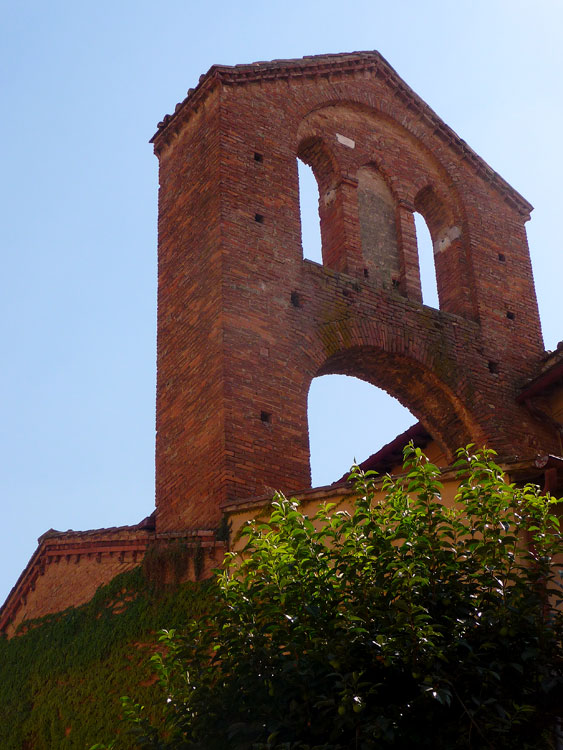 For no other reason than that I like the sound of the name, I decide to head for Sant’Agostino. It’s downhill, too, which makes a nice change. Hang on a minute, this can’t be right, I’m at the bottom of the hill, it’s getting all modern. Must have missed it…damm, back up the hill again, but maybe I’ll go the other way, through the garden.
For no other reason than that I like the sound of the name, I decide to head for Sant’Agostino. It’s downhill, too, which makes a nice change. Hang on a minute, this can’t be right, I’m at the bottom of the hill, it’s getting all modern. Must have missed it…damm, back up the hill again, but maybe I’ll go the other way, through the garden.
Which is all very pleasant, but still essentially up hill. Looking up at a huge brick bastion, topped with a tower/arch thing, I figure that must be the place. Quite a bit of sweaty, steeply uphill walking later I find a small sign on a wall that confirms that this is Sant’Agostino. Good. Just along the wall, though, is a handwritten sign apologising for being closed for renovations. Less good. At least there’s somewhere cool to sit – a small piazza full of plane trees – whilst I try and figure out what next. Examining the rather inadequate map in the guide book, I can’t help groaning quietly (it’s far too hot to do anything loudly) Not only is the only other place my ticket will admit me to a weary way away… I’ve also, somehow, contrived to place myself almost as far as you can get from the railway station.
What I really need is some motivation, something to help me along the way…and that’s why I ended up buying a shirt.
That’s my story, and I’m sticking to it!


